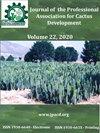Genetic relations among Moroccan Opuntia genotypes with different degrees of resistance to Dactylopius opuntiae
IF 0.4
4区 农林科学
Q4 HORTICULTURE
Journal of the Professional Association for Cactus Development
Pub Date : 2022-08-17
DOI:10.56890/jpacd.v24i.480
引用次数: 0
Abstract
Genetic diversity and relationship among a set of 18 cactus pear genotypes, with different degrees of resistance to cochineal scale insect (Dactylopius opuntiae), was estimated using eight simple sequence repeat (SSR) markers. The genotypes used belong to four Opuntia species (O. engelmanii, O. ficus indica, O. robusta, and o. dillenii). The analysis revealed a total number of 56 alleles (Mean = 7) and an average genetic diversity index of 0.76 with genetic distances ranging from 0.00 to 1.00 at eight microsatellite loci in 18 Moroccan cactus pear genotypes. All microsatellites used were found to be highly informative, with mean polymorphic information content (PIC) estimated at 0.72. Genetic relationship estimated using the neighbor-joining (NJ) method and the principal coordinate analysis (PCoA), showed that the 18 genotypes were successfully assigned to four clusters, separated according to their taxonomy distribution and their levels of resistance to D. opuntiae. The results of this study demonstrated that the Moroccan cactus pear genotypes evaluated are highly divergent and that these genotypes will be useful for future crossing programs to improve the genetic diversity in Opuntia for resistance to D. opuntiae.摩洛哥仙人掌不同抗性基因型的遗传关系
利用8个SSR标记,对18个对胭脂虫(Dactylopius opuntiae)具有不同抗性的仙人掌梨基因型的遗传多样性和亲缘关系进行了分析。所使用的基因型属于4个机会种(O. engelmanii, O. ficus indica, O. robusta和O. dillenii)。结果表明,18个摩洛哥仙人掌梨基因型的8个微卫星位点共有56个等位基因(平均7个),平均遗传多样性指数为0.76,遗传距离在0.00 ~ 1.00之间。所有使用的微卫星都具有很高的信息量,平均多态信息含量(PIC)估计为0.72。利用邻联法(NJ)和主坐标分析(PCoA)对18个基因型的亲缘关系进行了分析,结果表明,这18个基因型被划分为4个聚类,并根据它们的分类分布和对机会姬蚊的抗性水平进行了分离。本研究结果表明,所评价的摩洛哥仙人掌梨基因型具有高度的差异性,这些基因型将为今后的杂交计划提供依据,以提高摩洛哥仙人掌对仙人掌病抗性的遗传多样性。
本文章由计算机程序翻译,如有差异,请以英文原文为准。
求助全文
约1分钟内获得全文
求助全文
来源期刊

Journal of the Professional Association for Cactus Development
Agricultural and Biological Sciences-Plant Science
CiteScore
1.10
自引率
33.30%
发文量
10
期刊介绍:
The editors of the Journal of the Professional Association for Cactus Development, are very excited to be a part of the excellent editorial committee and to work together to create the synergism between scientists, growers, legislators, and business people so vital to the development of this industry to serve the people of arid lands.
 求助内容:
求助内容: 应助结果提醒方式:
应助结果提醒方式:


